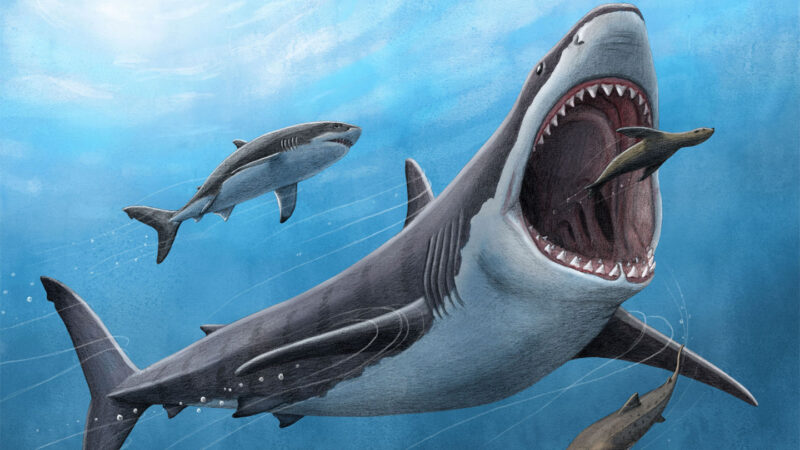Massive, megatoothed Otodus megalodon ran hot — the ancient shark was at least somewhat warm-blooded, new evidence shows.
Chemical measurements from fossil O. megalodon teeth suggest the sharks had higher body temperatures than their surrounding waters, researchers report June 26 in Proceedings of the National Academy of Sciences. Analyses of carbon and oxygen in the teeth of these and other sharks, both living and extinct, revealed that the giant shark’s body temperature was about 7 degrees Celsius warmer than estimated seawater temperatures at the time.
That warm-bloodedness may have been a double-edged sword. The trait may have helped O. megalodon become a swift, fearsome apex predator and grow up to 20 meters long, making it among the largest carnivores to ever live on Earth. But the shark’s voracious appetite may have also spelled the species’ ultimate doom. Gigantism has a high metabolic cost, says UCLA marine biogeochemist Robert Eagle: Bigger bodies require more food, and the massive sharks may have been particularly vulnerable to extinction when the climate changed and food became scarcer.
Mammals are well known for being able to metabolically elevate and maintain their body heat, even in colder environments, a trait called endothermy. But some fish lineages, both living and extinct, are capable of regional endothermy, maintaining some body parts at higher temperatures than the surrounding water (SN: 6/10/10). For example, many modern lamniform sharks — the group that includes species like mako and great white sharks — have this ability (SN: 8/2/18).
“Indeed, regional endothermy is one of just two known evolutionary pathways toward giant sizes in sharks,” says Jack Cooper, a paleobiologist at Swansea University in Wales who was not involved in the new study. (The other, Cooper says, is filter feeding, employed by gentler giants such as whale sharks.)
Scientists have long thought that megalodon was regionally endothermic, Eagle says, based on a variety of evidence such as estimates of the megashark’s body shape, as well as its likely swimming speeds and energy requirements. The shark was also known to have a very large geographic range around the globe, actively hunting in colder as well as warmer waters, which argues for some warm-bloodedness. A recent study by Cooper and colleagues that modeled the shark’s body in 3-D estimated that adult O. megalodon was a transoceanic superpredator, able to swim faster than any living shark species and fully consume prey the size of today’s largest predators.
The question, Eagle adds, isn’t really whether O. megalodon was endothermic — it’s how endothermic it was. In particular, the team wondered how its body temperatures compared to one of its primary ocean competitors, which appeared on the scene late in the shark’s reign: Carcharodon carcharias, better known as the great white shark (SN: 6/29/22).
O. megalodon appeared around 23 million years ago and went extinct sometime between 3.5 million and 2.6 million years ago. Great white sharks emerged around 3.5 million years ago, and they competed for food with their massive cousins. One hypothesis has been that this competition helped drive O. megalodon to extinction (SN: 5/31/22). Climate change during the Pliocene Epoch, which spanned 5.3 million to 2.6 million years ago, led to a collapse in the population of marine mammals, the primary food source for both sharks.
“The Carcharodon were much smaller … and persisted, whereas the Otodus went extinct,” Eagle says. “Carcharodon probably had a lower requirement for food to maintain its metabolic rate.”
To get more direct evidence of the body temperatures of these shark species, and therefore better understand their respective metabolisms, the team turned to the only fossils the sharks have left behind: their teeth.
Fossilized teeth offer a wealth of encapsulated environmental data. The tooth enamel contains both heavier and lighter forms, or isotopes, of carbon, oxygen and other elements, and the relative abundances of these isotopes is linked to body temperature. Eagle and his colleagues used a technique that examines the abundance of “clumped isotopes” — bonded-together heavy forms of carbon (carbon-13) and oxygen (oxygen-18) — as a kind of ancient geochemical thermometer. The abundance of these bonds is “only affected by temperature,” offering a more unambiguous thermometer than using a single element’s isotopic abundance, Eagle says.
The team used this technique on teeth from the different sharks, as well as fossil samples from other ancient ocean contemporaries including whales and mollusks. (Mollusks, being entirely cold-blooded, represent the ocean water temperature, Eagle says). The data show that both sharks were a bit endothermic, but not only was O. megalodon’s average body temperature (about 27⁰ C) higher than its surrounding waters, it was also higher than the average body temperature of great whites (about 22⁰ C) living in similar waters. Neither shark was as warm-blooded as marine mammals, such as the whale groups Odontoceti and Mysticeti, the team determined.
It’s “a very interesting finding, and it is fantastic that we have more evidence for regional endothermy in megalodon,” Cooper says. O. megalodon’s higher body temperature would have allowed it “to swim further and faster, increasing its chances of encountering prey,” he says. “But it also means that if food availability declines, megalodon would not have been able to meet its huge energetic requirements.” And when changing sea levels in the Pliocene led to a decline in the sharks’ prey about 3 million years ago, “it may well have starved into extinction.”
Eagle and colleagues are now delving into the chicken-or-egg question of which came first for O. megalodon: warm-bloodedness or apex predator status. “You need a high trophic level to become gigantic,” Eagle says. But is warm-bloodedness necessary to get to that high trophic level (apex predator status)? “We’re hoping to fit it all together into an evolutionary story as to what drives what.”


